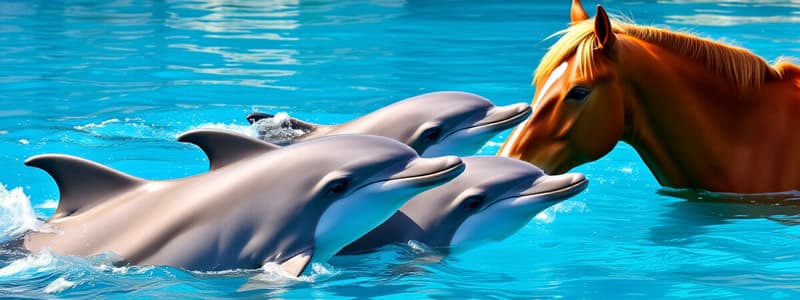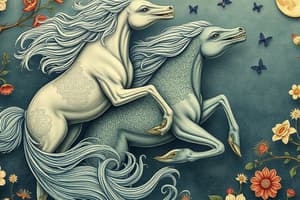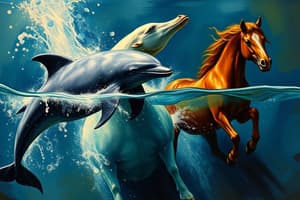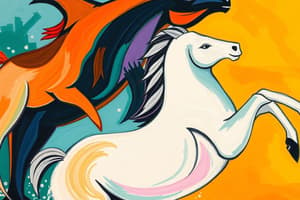Podcast
Questions and Answers
What type of diet do most crabs primarily follow?
What type of diet do most crabs primarily follow?
- Strictly herbivorous
- Insectivorous only
- Strictly carnivorous
- Omnivorous or scavengers (correct)
What is the primary food source for a hippopotamus?
What is the primary food source for a hippopotamus?
- Short grasses (correct)
- Fruits and vegetables
- Insects and small animals
- Meat and fish
Which type of lizard primarily preys on insects?
Which type of lizard primarily preys on insects?
- Omnivores
- Insectivores (correct)
- Carnivore lizards
- Herbivore lizards
What is unique about howler monkeys among the types of monkeys?
What is unique about howler monkeys among the types of monkeys?
What characteristic feature do jellyfish have to catch their prey?
What characteristic feature do jellyfish have to catch their prey?
What do thorn bugs consume?
What do thorn bugs consume?
In which types of habitats do crocodiles prefer to live?
In which types of habitats do crocodiles prefer to live?
What food category do capuchin monkeys primarily belong to?
What food category do capuchin monkeys primarily belong to?
What is a common behavior of hippos related to their feeding patterns?
What is a common behavior of hippos related to their feeding patterns?
How many types of monkeys exist today?
How many types of monkeys exist today?
Where do coastal dolphins typically live?
Where do coastal dolphins typically live?
Why do wild horses prefer plains and prairies?
Why do wild horses prefer plains and prairies?
What makes cheetahs unique among land animals?
What makes cheetahs unique among land animals?
What is the primary characteristic of the African savanna?
What is the primary characteristic of the African savanna?
What major threat do lions face in their natural habitat?
What major threat do lions face in their natural habitat?
Why are blue whales currently classified as endangered?
Why are blue whales currently classified as endangered?
What type of environment do domesticated horses adapt to?
What type of environment do domesticated horses adapt to?
Which herbivores might you find in the African savanna?
Which herbivores might you find in the African savanna?
What is a significant factor in the endangerment of cheetahs?
What is a significant factor in the endangerment of cheetahs?
What activity had a historical negative impact on blue whale populations?
What activity had a historical negative impact on blue whale populations?
What is the main cause of the great white shark becoming endangered?
What is the main cause of the great white shark becoming endangered?
At what age does a horse typically become a yearling?
At what age does a horse typically become a yearling?
What is the first stage of a crocodile's life cycle?
What is the first stage of a crocodile's life cycle?
Which mammal is known to be the fastest on land?
Which mammal is known to be the fastest on land?
What stage follows babyhood in a monkey's life cycle?
What stage follows babyhood in a monkey's life cycle?
What defines the cubs of a tiger in their early stages?
What defines the cubs of a tiger in their early stages?
How long can cheetahs sustain their burst of speed?
How long can cheetahs sustain their burst of speed?
What significantly contributes to the increasing population of great white sharks?
What significantly contributes to the increasing population of great white sharks?
How do snakes regulate their body temperature in their habitats?
How do snakes regulate their body temperature in their habitats?
What are young hens called until they lay eggs?
What are young hens called until they lay eggs?
What is the typical age at which a horse becomes an adult?
What is the typical age at which a horse becomes an adult?
What is the name of the stage when tiger cubs begin to learn how to hunt?
What is the name of the stage when tiger cubs begin to learn how to hunt?
What do cheetah cubs have to help them camouflage from predators?
What do cheetah cubs have to help them camouflage from predators?
At what age do lion cubs typically become sexually mature?
At what age do lion cubs typically become sexually mature?
Which of the following factors is not a threat to blue whales?
Which of the following factors is not a threat to blue whales?
What is the term for a female horse before she can lay eggs?
What is the term for a female horse before she can lay eggs?
What is the likely lifespan of a monkey?
What is the likely lifespan of a monkey?
What is the maximum speed a cheetah can reach?
What is the maximum speed a cheetah can reach?
What do we call the stage before birth in a crocodile's life cycle?
What do we call the stage before birth in a crocodile's life cycle?
What is an adaptation that helps cheetahs succeed in their environment?
What is an adaptation that helps cheetahs succeed in their environment?
What is one reason lions are becoming endangered?
What is one reason lions are becoming endangered?
Why do dolphins travel in pods?
Why do dolphins travel in pods?
What is a significant environmental threat to the cheetah population?
What is a significant environmental threat to the cheetah population?
What do wild horses need in their habitat for defense?
What do wild horses need in their habitat for defense?
Which of the following animals are typically herbivores found in the African savanna?
Which of the following animals are typically herbivores found in the African savanna?
Which activity led to the endangerment of blue whales?
Which activity led to the endangerment of blue whales?
What type of habitat do dolphins typically inhabit?
What type of habitat do dolphins typically inhabit?
Which factor contributes to the endangerment of lions besides habitat destruction?
Which factor contributes to the endangerment of lions besides habitat destruction?
What type of terrain do horses prefer for their natural habitat?
What type of terrain do horses prefer for their natural habitat?
What primary food source do herbivores in the savanna rely on?
What primary food source do herbivores in the savanna rely on?
What aspect of a jellyfish aids in capturing prey?
What aspect of a jellyfish aids in capturing prey?
What unique feeding behavior do thorn bugs exhibit?
What unique feeding behavior do thorn bugs exhibit?
Which type of monkey is primarily focused on consuming leaves?
Which type of monkey is primarily focused on consuming leaves?
What is a significant characteristic of hippo feeding behavior?
What is a significant characteristic of hippo feeding behavior?
Which of the following best describes crabs in terms of diet?
Which of the following best describes crabs in terms of diet?
What type of animal is a lizard classified as based on its diet?
What type of animal is a lizard classified as based on its diet?
What is a defining feature of crocodile habitats?
What is a defining feature of crocodile habitats?
Which body part do jellyfish use to capture their food?
Which body part do jellyfish use to capture their food?
What distinguishes omnivorous monkeys from others?
What distinguishes omnivorous monkeys from others?
How do thorn bugs blend into their environment?
How do thorn bugs blend into their environment?
Flashcards are hidden until you start studying
Study Notes
Dolphins
- Dolphins thrive in moderate to warm ocean and sea waters globally.
- Coastal dolphins favor shallower waters near beaches, while offshore dolphins are larger and inhabit deeper ocean areas.
- They rely on pods for finding food and evading predators, emphasizing the importance of social structures.
Horses
- Domesticated horses are adaptable to various habitats; wild horses prefer plains, prairies, and steppes.
- Horses require open spaces for defense and shelters like trees or cliffs for protection from elements.
- As herbivores, they consume large quantities of grass and need access to fresh water.
Cheetahs
- Cheetahs hold the title of the fastest land animals, known for their incredible speed.
- They have become endangered due to habitat loss, reduced prey availability, and threats from humans, including hunting.
African Savanna
- Savannas cover nearly half of Africa, acting as a transitional zone between rainforests and deserts.
- This habitat exhibits warm temperatures and various grasses, supporting diverse wildlife.
- Large herbivores such as giraffes, zebras, and elephants thrive here, along with carnivores like lions and hyenas.
- Preservation efforts are critical due to habitat destruction and hunting pressures.
Lions
- Lions face extinction risks due to habitat destruction and decreased prey populations from human activities.
- Conservationists are actively working to bolster lion populations through various protective measures.
Blue Whales
- Blue whales, critically endangered, were heavily hunted until whaling became illegal in 1966.
- Current threats include boat collisions, anthropogenic noise, pollution, climate change, and challenges in prey availability due to fishing.
Great White Sharks
- Great white sharks are endangered primarily due to human-induced threats such as pollution and illegal fishing.
- Protective laws and bans on shark fin soup are contributing to recovery efforts.
Snakes
- Snakes inhabit diverse environments, particularly favoring warm, tropical climates.
- They have adaptive behaviors for temperature regulation, moving to cooler or warmer areas as needed.
Horse Life Cycle
- The life cycle of a horse includes stages: foal (birth), yearling (one year), colt (male), and filly (female) development until adulthood at around four years old.
Lion Life Cycle
- Lion cubs experience rapid development, learning essential survival skills within the first six years of life.
Tiger Life Cycle
- The tiger life cycle includes stages from newborn cubs requiring maternal care to young tigers that transition to independence between 17 months and two years.
Crocodile Life Cycle
- Crocodiles exhibit a three-stage life cycle: pre-birth (nest building), young (hatching and early development), and adult stages.
Monkey Life Cycle
- The monkey life cycle begins in gestation inside the mother's womb, followed by stages of babyhood and adulthood, with a faster timeline than that of humans.
Chicken Life Cycle
- Hens hatch from eggs covered in down, becoming pullets until they can lay eggs shortly after breeding.
- Lifespan varies, ranging from 2 to over 25 years depending on environmental conditions.
Cheetah Cubs
- Cheetah cubs are born small and vulnerable, typically in litters of three to five.
- Their distinctive mantle provides camouflage, aiding survival from predators while they learn to hunt through play.
Cheetah Adaptations
- Cheetahs can reach speeds of 60 miles per hour in three seconds but can only maintain such bursts for about 30 seconds before tiring.
White Bengal Tigers
- Snow tigers, or white Bengal tigers, lack pheomelanin pigment, giving them a unique snow-colored appearance.
- All existing snow tigers are found in captivity.
Horse Nutrition
- Horses require a balanced diet of grass, hay, grains, fruits, and vegetables, complemented by ample water intake.
Crabs
- Over 4,000 crab species exist, with diverse diets ranging from scavenging to specific carnivorous or omnivorous feeding habits.
Hippopotamus
- Hippopotamuses are large, water-dwelling herbivores primarily grazing on short grasses, capable of altering their environment through feeding patterns.
Lizards
- With thousands of lizard species, their diet varies according to their habitat, encompassing herbivores, carnivores, and omnivores, including insectivores.
Monkeys
- Over 260 monkey species exist, predominantly omnivorous; specific types include howler monkeys (foliovores) and owl monkeys (frugivores).
Jellyfish
- Jellyfish are ancient, gelatinous invertebrates that play a carnivorous role in marine ecosystems and often form large groups known as blooms.
Thorn Bugs
- Thorn bugs possess a thorn-like horn for camouflage and primarily feed on plant sap, occasionally being viewed as pests.
Crocodiles
- Crocodiles inhabit tropical regions globally, preferring brackish water and safe egg-laying sites, yet habitat loss due to human expansion threatens some species.
Dolphins
- Dolphins thrive in moderate to warm ocean and sea waters globally.
- Coastal dolphins favor shallower waters near beaches, while offshore dolphins are larger and inhabit deeper ocean areas.
- They rely on pods for finding food and evading predators, emphasizing the importance of social structures.
Horses
- Domesticated horses are adaptable to various habitats; wild horses prefer plains, prairies, and steppes.
- Horses require open spaces for defense and shelters like trees or cliffs for protection from elements.
- As herbivores, they consume large quantities of grass and need access to fresh water.
Cheetahs
- Cheetahs hold the title of the fastest land animals, known for their incredible speed.
- They have become endangered due to habitat loss, reduced prey availability, and threats from humans, including hunting.
African Savanna
- Savannas cover nearly half of Africa, acting as a transitional zone between rainforests and deserts.
- This habitat exhibits warm temperatures and various grasses, supporting diverse wildlife.
- Large herbivores such as giraffes, zebras, and elephants thrive here, along with carnivores like lions and hyenas.
- Preservation efforts are critical due to habitat destruction and hunting pressures.
Lions
- Lions face extinction risks due to habitat destruction and decreased prey populations from human activities.
- Conservationists are actively working to bolster lion populations through various protective measures.
Blue Whales
- Blue whales, critically endangered, were heavily hunted until whaling became illegal in 1966.
- Current threats include boat collisions, anthropogenic noise, pollution, climate change, and challenges in prey availability due to fishing.
Great White Sharks
- Great white sharks are endangered primarily due to human-induced threats such as pollution and illegal fishing.
- Protective laws and bans on shark fin soup are contributing to recovery efforts.
Snakes
- Snakes inhabit diverse environments, particularly favoring warm, tropical climates.
- They have adaptive behaviors for temperature regulation, moving to cooler or warmer areas as needed.
Horse Life Cycle
- The life cycle of a horse includes stages: foal (birth), yearling (one year), colt (male), and filly (female) development until adulthood at around four years old.
Lion Life Cycle
- Lion cubs experience rapid development, learning essential survival skills within the first six years of life.
Tiger Life Cycle
- The tiger life cycle includes stages from newborn cubs requiring maternal care to young tigers that transition to independence between 17 months and two years.
Crocodile Life Cycle
- Crocodiles exhibit a three-stage life cycle: pre-birth (nest building), young (hatching and early development), and adult stages.
Monkey Life Cycle
- The monkey life cycle begins in gestation inside the mother's womb, followed by stages of babyhood and adulthood, with a faster timeline than that of humans.
Chicken Life Cycle
- Hens hatch from eggs covered in down, becoming pullets until they can lay eggs shortly after breeding.
- Lifespan varies, ranging from 2 to over 25 years depending on environmental conditions.
Cheetah Cubs
- Cheetah cubs are born small and vulnerable, typically in litters of three to five.
- Their distinctive mantle provides camouflage, aiding survival from predators while they learn to hunt through play.
Cheetah Adaptations
- Cheetahs can reach speeds of 60 miles per hour in three seconds but can only maintain such bursts for about 30 seconds before tiring.
White Bengal Tigers
- Snow tigers, or white Bengal tigers, lack pheomelanin pigment, giving them a unique snow-colored appearance.
- All existing snow tigers are found in captivity.
Horse Nutrition
- Horses require a balanced diet of grass, hay, grains, fruits, and vegetables, complemented by ample water intake.
Crabs
- Over 4,000 crab species exist, with diverse diets ranging from scavenging to specific carnivorous or omnivorous feeding habits.
Hippopotamus
- Hippopotamuses are large, water-dwelling herbivores primarily grazing on short grasses, capable of altering their environment through feeding patterns.
Lizards
- With thousands of lizard species, their diet varies according to their habitat, encompassing herbivores, carnivores, and omnivores, including insectivores.
Monkeys
- Over 260 monkey species exist, predominantly omnivorous; specific types include howler monkeys (foliovores) and owl monkeys (frugivores).
Jellyfish
- Jellyfish are ancient, gelatinous invertebrates that play a carnivorous role in marine ecosystems and often form large groups known as blooms.
Thorn Bugs
- Thorn bugs possess a thorn-like horn for camouflage and primarily feed on plant sap, occasionally being viewed as pests.
Crocodiles
- Crocodiles inhabit tropical regions globally, preferring brackish water and safe egg-laying sites, yet habitat loss due to human expansion threatens some species.
Studying That Suits You
Use AI to generate personalized quizzes and flashcards to suit your learning preferences.




